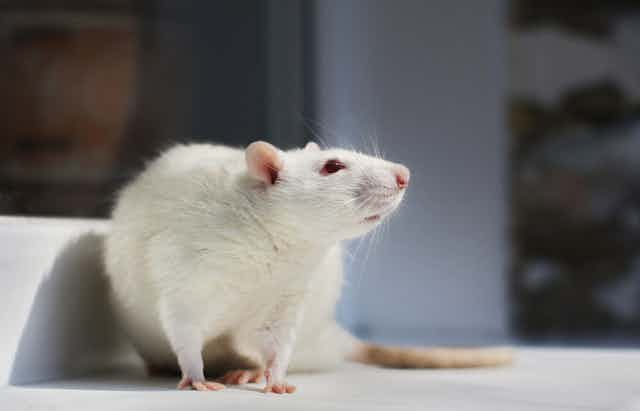Our series, Animals in Research, profiles the top organisms used for science experimentation. In this instalment, we look at the original lab rats: Rattus norvegicus.
Rats have a long history in medical research: they were the first mammalian species specifically domesticated to be used in the laboratory.
Records dating back to the 1850s show these animals were derived from those bred by rat fanciers who collected them for their unique coat colours and behavioural characteristics.
The success of the rat in research today has been linked to the Wistar Institute in America and their development of the Wistar albino strain. There are currently 117 albino strains of the laboratory rat, all of which can be traced genetically back to the one rat, likely to have arisen as a mutation from a hooded (piebald) rat strain.

Since their development as a laboratory species, rats have been used to answer a wide range of basic science questions ranging from physiology, immunology, pharmacology, toxicology, nutrition, behaviour and learning.
Consequently, a large amount of data has been collected that has translated into their extensive use as a model for human disease.
Rats vs mice
Researchers will choose rats over mice when it comes to their use in research for a number of reasons. They are larger in size which makes handling, sampling and performing procedures easier.
For physiological studies, we know a lot more about the responses and pathways in rats than we do in mice due to the wealth of data collected over years of study in the rat, meaning much of the foundation research is already done.
Some work suggests the rat more accurately reflects human physiology than mice do, mimicking human disease more accurately in many cases.
Behavioural research also shows they are more suited to studies of learning and cognition because they are more capable of learning tasks than mice.
The first rat maze was built 100 or so years ago by experimental psychologist Willard Small, who wanted to study the process of learning, and since then rats have enabled the development of many complex learning and conditioning theories.
Their ability to learn, remember, press buttons, levers, and even ride skateboards gives them a huge advantage over mice and also allows us to look at the most basic principles behind learning and behaviour which can then be translated to our knowledge of human behaviour and learning.
The main advantage that mice did have over rats until the past few years was that scientists had the ability to manipulate mouse DNA to produce transgenic animals, where specific genes can be modified or even removed in order to study their function in health and disease.
But with the advent of the mapping of the rat genome and recent technical advances, this can now also be done in rats, allowing the creation of “knock-in” (the insertion of a gene at a specific location on the chromosome) and “knock-out” (making a gene inoperative) rat strains to study very specific research questions.
Biomedical research
Rats have a prevalence within biomedical research second only to humans and they share 90% of the genome with humans. Almost all disease-linked human genes we currently know of have equivalent genes within the rat genome, making them a suitable research tool.
Well-established strains of rat are used to study a number of human diseases such as:
- obesity and diabetes
- cancer
- cardiovascular disease (including high blood pressure and heart failure)
- neurological diseases (such as Parkinson’s disease)
- inflammatory and immune mediated diseases (such as certain types of kidney disease and multiple sclerosis)

The strains of rat that have been developed to express human diseases were achieved through a number of different processes. It may be that the strain carrying a particular disease feature occurred spontaneously and the animals were then selectively bred. In some cases this has led to identification of the genetic mutation that causes a comparable human disease.
This is what happened with the PCK rat (a rat with a mutation in the pck gene). Genetic analysis of the mutation in the PCK rat, which had a kidney disease called polycystic kidney disease (PKD), led to the discovery of the PKHD1 gene, which encodes for a protein called fibrocystin.
Researchers went back to the human data and found that a mutation in the same gene was also responsible for PKD in humans.
Alternatively, a genetic defect may be “introduced”. This is what was done recently when a new model of Parkinson’s disease in rats was produced by expressing the mutant human gene for a common genetic cause of Parkinson’s in the brain of Wistar rats.

In some cases, genetics and environment can interact, and a change in the rats’ environment can induce disease in susceptible animals. High blood pressure is a good example. Sprague Dawley rats were fed a very high salt diet, and the animals were then selected and bred on the basis of their blood pressure either increasing or staying normal.
Within three generations of breeding, salt-sensitive and salt-resistant strains were clearly evident, suggesting for the first time that salt sensitivity was an inherited trait and that similar factors may apply in humans.
These rats are now widely used to study salt and the role it plays in causing high blood pressure in people.
Other models of disease in rats may be induced by chemical or surgical means.
The rat has allowed us to build up an incredible wealth of knowledge about basic biology and complex physiological interactions, and has served as a model of human disease and learning, much of which has been translated to greater knowledge about humans.
While we will never be able to have a model that fully replicates the extent of the our own complex physical and behavioural state, the fancy rat has greatly progressed our understanding of many different diseases and disorders, and they will likely continue to provide a very valuable contribution to research.

